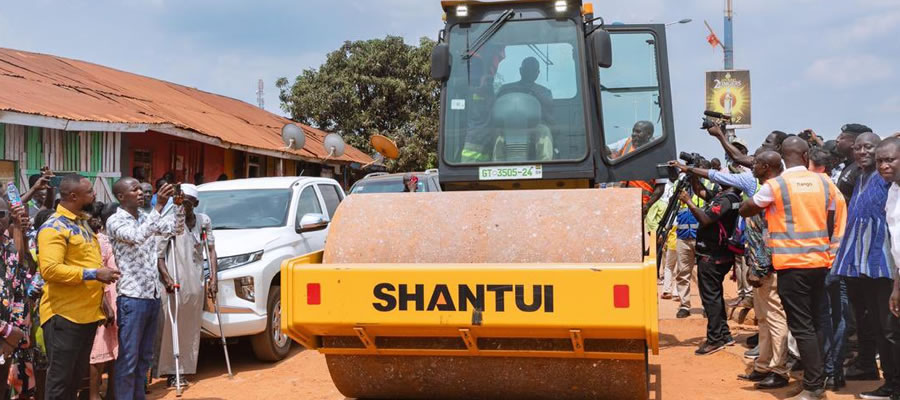

The History of Berekum
The emergence of Berekum has historical antecedent. The war between Asantes and Domaas gave rise to the creation of Berekum by Asantehene. Berekum was to check the military movements of the Domaas and report findings to the Asantehene. The first chief of Berekum was Nana Amankona Diawuo I who reigned between 1732 and 1765 with Nana Ameahene I as his queen mother. He came from Asokore to build the town. As time went by people from Adansi also came to join those from Asokore. Nana Amankona Diawuo I married a woman from Adansi and had children with her. One of his sons later became the chief of Berekum. The traditional stool is from Asokore (Ekoona Clan).
Some groups also came from Denkyira, notably Biadan and Atonotia descendants. Some also came from Takyiman to settle. People of Adom and Amankokwaa belong to such group.
The Berekum West District Assembly is one of the 254 Metropolitan/Municipal/District Assemblies in Ghana is mandated by law to prepare a Medium Term Development Plan with a framework and guidelines provided by the National Development Planning Commission (NDPC).
Berekum West District Assembly is one of the 29 administrative districts of the Brong Ahafo Region. It was established by legislative Instrument (L.I. 2337). Jinijini serves as both the traditional and administrative capital of the district. The Assembly has 27 Assembly Members-19 Elected and 8 Government Appointees. There are 4 Area Councils namely; Koraso, Nsapor, Jinijini and Fetentaa. There are 19 Electoral Areas and 24 Settlements in the District. It was created in pursuance of deepening decentralization and good governance in Ghana.
The district profile comprises of the Physical and Natural Environment with respect to Location and Size, Climate and Vegetation, Mineral and Geology, Culture, Settlement Systems, Economy of the District, Food Security, Governance, Social Services, Vulnerability Analysis, Information Communication and Technology, HIV/AIDS, Gender, Environment, Climate Change and Green Economy, Population, Science, Technology and Innovation, Security, Disaster and other facilities/issues in the District.
It also contains the analysis of the existing situation from survey information obtained which reveals the community problems, felt needs and development aspirations of the entire community and the District at large. This is to provide information where inferences can be drawn for appropriate recommendations to inform decision making.
Vision, Mission Statements and Functions of the District Assembly
Berekum West District Assembly is the central institution within the District responsible for planning, implementation and management of development programmes and projects. The Assembly exercises deliberative, legislative and executive functions. They have been established as structures to which they are assigned with the responsibility of integrating political, administrative and development resources to achieve more equitable allocation of power and wealth at the District.
Vision Statement of the District Assembly
A District geared “towards the equality of life and high standard of living by having access to all socio-economic services and also promote effective grass root participation geared towards the overall development of the district in partnership with other administrative authorities”.
Mission Statement of the District Assembly
The Berekum West District Assembly exists “to improve upon the quality and standard of living of the people in a more coordinated manner and also provide socio-economic services to the people by expediting the maintenance of law and order for a more harmonious and uniformed environment through the formulation of policies in collaboration with stakeholders”.
Functions of the Berekum West District Assembly
The Berekum West District Assembly was created as a pivot of the administrative and development decision making body and the basic unit of Local Government Administration. Subject to the Local Governance Act, 2016 (Act 936), the District Assembly shall exercise political and administrative authority, provide guidance, give direction to and supervise all other administrative authorities in the district.
Section 10 (3) of Act 936 prescribes the functions of the Assembly as follows:
Responsible for the overall development of the district. The District Assembly ensures the preparation and submission of Development Action Plans through the Regional Co-coordinating Council to NDPC and budgets to the Ministry of Finance for approval.
- Formulate and execute plans, programmes and strategies for the effective mobilization of the resources necessary for the overall development of the District.
- Promote and support productive activity and social development in the district and remove any obstacles to initiate development;
- Initiate programmes for the development of basic infrastructure and provide district works and services;
- Be responsible for the development, improvement and management of human settlements and the environment in the district;
- In co-operation with the appropriate national and local security agencies be responsible for the maintenance of security and public safety in the district;
- Ensure ready access to courts in the District for the promotion of justice;
- Initiate, sponsor or carry out such studies as may be necessary for the discharge of any of the functions conferred by this Act or any other enactment
Date Created : 2/1/2019 3:35:36 AM











 facebook
facebook
 twitter
twitter
 Youtube
Youtube
 +233 593 831 280
+233 593 831 280 0800 430 430
0800 430 430 GPS: GE-231-4383
GPS: GE-231-4383 info@ghanadistricts.com
info@ghanadistricts.com Box GP1044, Accra, Ghana
Box GP1044, Accra, Ghana